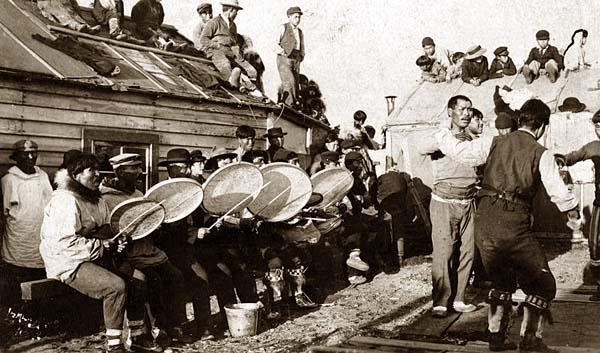|
Pinga (goddess)
In the Inuit religion, Pinga ("the one who is p onhigh") is a goddess of the hunt and medicine. She is heavily associated with the sky. Caribou Inuit tradition In Caribou Inuit communities, Pinga had some authority over caribou herds. She would become angry if people killed more caribou than they could eat, so Caribou communities were careful not to over-hunt. Pinga was also a psychopomp Psychopomps (from the Greek word , , literally meaning the 'guide of souls') are creatures, spirits, angels, demons, or deities in many religions whose responsibility is to escort newly deceased souls from Earth to the afterlife. Their role is ..., receiving the souls of the newly deceased and preparing them for reincarnation. '' Angakkuit'' (shamans) might have seen or communicated with Pinga, or sometimes she may have sent a spirit to speak with them. Some Caribou Inuit viewed Sila and Pinga as the same or similar, while other communities differentiated between the two. Notes Reference ... [...More Info...] [...Related Items...] OR: [Wikipedia] [Google] [Baidu] |
Inuit Religion
Inuit religion is the shared spiritual beliefs and practices of the Inuit, an indigenous people from Alaska, northern Canada, Greenland, and parts of Siberia. Their religion shares many similarities with some Alaska Native religions. Traditional Inuit religious practices include animism and shamanism, in which spiritual healers mediate with spirits. Today many Inuit follow Christianity (with 71 percent of Canadian Inuit identifying as Christian ); however, traditional Inuit spirituality continues as part of a living, oral tradition and part of contemporary Inuit society. Inuit who balance indigenous and Christian theology practice religious syncretism. Inuit cosmology provides a narrative about the world and the place of people within it. Rachel Qitsualik-Tinsley writes: Traditional stories, rituals, and taboos of the Inuit are often precautions against dangers posed by their harsh Arctic environment. Knud Rasmussen asked his guide and friend Aua, an ''angakkuq'' (spiritual h ... [...More Info...] [...Related Items...] OR: [Wikipedia] [Google] [Baidu] |
Caribou Inuit
Kivallirmiut, also called the Caribou Inuit (/ᑭᕙᓪᓕᕐᒥᐅᑦ), barren-ground caribou hunters, are Inuit who live west of Hudson Bay in Kivalliq Region, Nunavut, between 61° and 65° N and 90° and 102° W in Northern Canada. The Denmark, Danish Fifth Thule Expedition of 19211924 led by Knud Rasmussen called them the Caribou Eskimo. Kivallirmiut are the southernmost subgroup of the Central Inuit. Groups ;Ahialmiut Ahiarmiut (Ahialmiut) relied on Reindeer, caribou year-round. They spent summers on the Qamanirjuaq calving grounds at Qamanirjuaq Lake ("huge lake adjoining a river at both ends") and spent winters following the herd to the north. ;Akilinirmiut Akilinirmiut were located in the Thelon River area by the Akiliniq Hills (''A-ki'', meaning "the other side") to the north of Beverly Lake and also visible above Aberdeen Lake. Some lived northwest of Baker Lake (''Qamani'tuuaq''), along with Qairnirmiut and Hauniqturmiut. Many relocated to Aberdeen Lake because of ... [...More Info...] [...Related Items...] OR: [Wikipedia] [Google] [Baidu] |
Reindeer
The reindeer or caribou (''Rangifer tarandus'') is a species of deer with circumpolar distribution, native to Arctic, subarctic, tundra, taiga, boreal, and mountainous regions of Northern Europe, Siberia, and North America. It is the only representative of the genus ''Rangifer''. More recent studies suggest the splitting of reindeer and caribou into six distinct species over their range. Reindeer occur in both Animal migration, migratory and wiktionary:sedentary#Adjective, sedentary populations, and their herd sizes vary greatly in different regions. The tundra subspecies are adapted for extreme cold, and some are adapted for long-distance migration. Reindeer vary greatly in size and color from the smallest, the Svalbard reindeer (''R.'' (''t.'') ''platyrhynchus''), to the largest, Osborn's caribou (''R. t. osborni''). Although reindeer are quite numerous, some species and subspecies are in decline and considered Vulnerable species, vulnerable. They are unique among deer (Ce ... [...More Info...] [...Related Items...] OR: [Wikipedia] [Google] [Baidu] |
Psychopomp
Psychopomps (from the Greek word , , literally meaning the 'guide of souls') are creatures, spirits, angels, demons, or deities in many religions whose responsibility is to escort newly deceased souls from Earth to the afterlife. Their role is not to judge the deceased, but simply to guide them. Appearing frequently on funerary art, psychopomps have been depicted at different times and in different cultures as anthropomorphic entities, horses, deer, dogs, whip-poor-wills, ravens, crows, vultures, owls, sparrows, and cuckoos. In the case of birds, these are often seen in huge masses, waiting outside the home of the dying. Overview Ancient religion Classical examples of a psychopomp are the ancient Egyptian god Anubis, the deity Pushan in Hinduism, the Greek ferryman Charon, the goddess Hecate, and god Hermes,RADULOVI, IFIGENIJA; VUKADINOVI, SNEŽANA; SMIRNOVBRKI, ALEKSANDRA – Hermes the Transformer Ágora. Estudos Clássicos em debate, núm. 17, 2015, pp. 45–62 Univers ... [...More Info...] [...Related Items...] OR: [Wikipedia] [Google] [Baidu] |
Angakkuq
The Inuit angakkuq (plural: ''angakkuit'', Inuktitut syllabics ᐊᖓᑦᑯᖅ or ᐊᖓᒃᑯᖅ; Inuvialuktun: '; , pl. ''angakkut''; Iñupiaq: ''aŋatkuq'') is an intellectual and spiritual figure in Inuit culture who corresponds to a medicine man. Other cultures, including Alaska Natives, have traditionally had similar spiritual mediators, although the Alaska Native religion has many forms and variants. Role in Inuit society Both women, such as Uvavnuk, and men could become an angakkuq, although it was rarer for women to do so. The process for becoming an angakkuq varied widely. The son of a current angakkuq might be trained by his father to become one as well. A shaman might make a prophecy that a particular infant would become a prophet in adulthood. Alternatively, a young man or woman who exhibited a predilection or power that made them stand out might be trained by an experienced mentor. There are also instances of angakkuit claiming to have been called to the role ... [...More Info...] [...Related Items...] OR: [Wikipedia] [Google] [Baidu] |
Silap Inua
In Inuit religion, Silap Inua ('possessor of spirit', ᓯᓚᑉ ᐃᓄᐊ) or Sila ('breath, spirit', ᓯᓪᓚ) ( Iñupiaq: ''siḷam iñua'') is similar to mana or ether, the primary component of everything that exists; it is also the breath of life and the method of locomotion for any movement or change. Silla was believed to control everything that goes on in one's life. Description Silla is a spirit of the sky, the wind, and the weather. Though identified as male, he is never depicted, and thought to be formless. There are very few myths in which Silla is a character, because he is not thought to have many personality characteristics. He also represents a concept somewhat akin to the Hindu idea of Paramatman, or Emerson’s idea of the great Over soul: Silla is also believed to be the substance which souls are made of. Contrary to the Christian missionaries who have identified Nanook the polar bear spirit as the supreme deity of the Inuit, Silla is much closer to this role ... [...More Info...] [...Related Items...] OR: [Wikipedia] [Google] [Baidu] |
Animal Goddesses
Animals are multicellular, eukaryotic organisms in the biological kingdom Animalia (). With few exceptions, animals consume organic material, breathe oxygen, have myocytes and are able to move, can reproduce sexually, and grow from a hollow sphere of cells, the blastula, during embryonic development. Animals form a clade, meaning that they arose from a single common ancestor. Over 1.5 million living animal species have been described, of which around 1.05 million are insects, over 85,000 are molluscs, and around 65,000 are vertebrates. It has been estimated there are as many as 7.77 million animal species on Earth. Animal body lengths range from to . They have complex ecologies and interactions with each other and their environments, forming intricate food webs. The scientific study of animals is known as zoology, and the study of animal behaviour is known as ethology. The animal kingdom is divided into five major clades, namely Porifera, Ctenophora, Placozoa, C ... [...More Info...] [...Related Items...] OR: [Wikipedia] [Google] [Baidu] |
Death Goddesses
Death is the end of life; the irreversible cessation of all biological functions that sustain a living organism. Death eventually and inevitably occurs in all organisms. The remains of a former organism normally begin to decompose shortly after death. Some organisms, such as '' Turritopsis dohrnii'', are biologically immortal; however, they can still die from means other than aging. Death is generally applied to whole organisms; the equivalent for individual components of an organism, such as cells or tissues, is necrosis. Something that is not considered an organism, such as a virus, can be physically destroyed but is not said ''to die'', as a virus is not considered alive in the first place. As of the early 21st century, 56 million people die per year. The most common reason is aging, followed by cardiovascular disease, which is a disease that affects the heart or blood vessels. As of 2022, an estimated total of almost 110 billion humans have died, or roughly 9 ... [...More Info...] [...Related Items...] OR: [Wikipedia] [Google] [Baidu] |
Hunting Goddesses
Hunting is the Human activity, human practice of seeking, pursuing, capturing, and killing wildlife or feral animals. The most common reasons for humans to hunt are to obtain the animal's body for meat and useful animal products (fur/hide (skin), hide, bone/tusks, horn (anatomy), horn/antler, etc.), for recreation/taxidermy (see trophy hunting), although it may also be done for resourceful reasons such as removing predators dangerous to humans or domestic animals (e.g. wolf hunting), to pest control, eliminate pest (organism), pests and nuisance animals that damage crops/livestock/poultry or zoonosis, spread diseases (see varmint hunting, varminting), for trade/tourism (see safari), or for conservation biology, ecological conservation against overpopulation and invasive species (commonly called a culling#Wildlife, cull). Recreationally hunted species are generally referred to as the ''game (food), game'', and are usually mammals and birds. A person participating in a hunt is a ... [...More Info...] [...Related Items...] OR: [Wikipedia] [Google] [Baidu] |
Inuit Goddesses
Inuit (singular: Inuk) are a group of culturally and historically similar Indigenous peoples traditionally inhabiting the Arctic and Subarctic regions of North America and Russia, including Greenland, Labrador, Quebec, Nunavut, the Northwest Territories, Yukon (traditionally), Alaska, and the Chukotsky District of Chukotka Autonomous Okrug. The Inuit languages are part of the Eskaleut languages, also known as Inuit-Yupik-Unangan, and also as Eskimo–Aleut. Canadian Inuit live throughout most of Northern Canada in the territory of Nunavut, Nunavik in the northern third of Quebec, the Nunatsiavut in Labrador, and in various parts of the Northwest Territories and Yukon (traditionally), particularly around the Arctic Ocean, in the Inuvialuit Settlement Region. These areas are known, by Inuit Tapiriit Kanatami and the Government of Canada, as Inuit Nunangat. In Canada, sections 25 and 35 of the Constitution Act of 1982 classify Inuit as a distinctive group of Aboriginal Canadi ... [...More Info...] [...Related Items...] OR: [Wikipedia] [Google] [Baidu] |
Health Goddesses
Health has a variety of definitions, which have been used for different purposes over time. In general, it refers to physical and emotional well-being, especially that associated with normal functioning of the human body, absent of disease, pain (including mental pain), or injury. Health can be promoted by encouraging healthful activities, such as regular physical exercise and adequate sleep, and by reducing or avoiding unhealthful activities or situations, such as smoking or excessive stress. Some factors affecting health are due to individual choices, such as whether to engage in a high-risk behavior, while others are due to structural causes, such as whether the society is arranged in a way that makes it easier or harder for people to get necessary healthcare services. Still, other factors are beyond both individual and group choices, such as genetic disorders. History The meaning of health has evolved over time. In keeping with the biomedical perspective, early definit ... [...More Info...] [...Related Items...] OR: [Wikipedia] [Google] [Baidu] |






